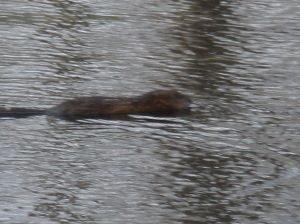If a tree falls in the woods, and nobody is there to hear it, does it make noise? I have no idea, but it does make a mess!
I took my camera running with me on Tuesday, so I could take pictures of the aftermath of “Superstorm Sandy”. The first surprise was how much water there was in and around the river. I expected the Corps of Engineers to hold a pond above the dam, that’s what it’s there for, but the water below the dam was high, too. The outlet pipes in the pond below the dam were completely under water. We didn’t have much rain with the storm, mostly just wind, so the water seemed high to me.
All summer, and thru the fall, the water level going through the dam has stayed at about 3 feet. Two days after the storm, there was 7 feet of water going thru. This is still pretty low, 10 or 12 feet isn’t unusual after a huge storm. (The highest water level recorded at the dam was 27 feet high on the tower in April of 1987. So 7 feet is no big deal). These are the fishing steps near the bridge. They have all been out of the water for months, and now the three bottom ones are in the water.
There is way more water at the beaver dam than a couple of weeks ago. That was then:
This is now. I wonder if the beavers are still in the lodge, or if the water is too high for them.
There were a few trees down, but less than I expected with all the wind. This is another view of the big pine tree from the beginning of this post.
The new bridge didn’t float away! There was no way to cross it without getting your feet wet, but it didn’t go anywhere.

(By Wednesday, the bridge was accessible again.) It’s always interesting to see how the weather affects the landscape. The water rises very quickly, but goes down even more surprisingly fast! Can’t wait to see what next week will bring. Go play outside! Do it now, before the snow.



















